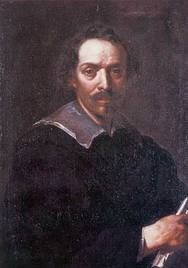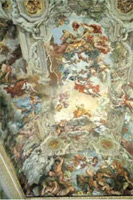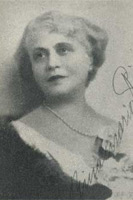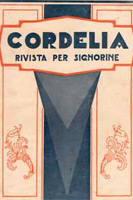
Il soggiorno

La suite matrimoniale

La camera da letto

Il caminetto

Vista esterna

Il giardino

Il Poggio

San Niccolo
The history
 The edification of Casa Berrettini dates back, most likely, to the beginning of 1500. It is certainly owned by Famiglia Berrettini since 1524 and there Pietro Berrettini was born (Cortona 1597 - Rome 1669) known also as “Pietro da Cortona” or simply “il Cortona”. Architect and painter among the most famous in 1600, father of the “Barocco” style, well known in the world for the number of his works that still remain. Pietro Berrettini lived in Cortona for a few years but the Casa remained as property of famiglia Berrettini till 1707, after which it was donated to the Congregation of San Filippo Neri. In 1759 the Congregation sold Casa Berrettini to a private buyer and after several more dealings it become property in 1882 of the ancestors of the present owner.
The edification of Casa Berrettini dates back, most likely, to the beginning of 1500. It is certainly owned by Famiglia Berrettini since 1524 and there Pietro Berrettini was born (Cortona 1597 - Rome 1669) known also as “Pietro da Cortona” or simply “il Cortona”. Architect and painter among the most famous in 1600, father of the “Barocco” style, well known in the world for the number of his works that still remain. Pietro Berrettini lived in Cortona for a few years but the Casa remained as property of famiglia Berrettini till 1707, after which it was donated to the Congregation of San Filippo Neri. In 1759 the Congregation sold Casa Berrettini to a private buyer and after several more dealings it become property in 1882 of the ancestors of the present owner.
The Celebrities
Casa Pietro Berrettini, known for being the place of birth of the famous painter and architect, has also given hospitality to the writer and poet Rina Maria Pierazzi who lived there from 1940 to 1962, date of her death.
Pietro Berrettini from Cortona

He was born in Cortona in 1597 in the House named after him and died in Rome in 1669. Here he was buried in the “Chiesa dei Santi Luca e Martina”, which was built under his drawing. A table on the façade of Casa Pietro Berrettini is a remembrance of the importance and honours received. The artist is among the maximum leading characters of the “Italian barocco” as well as a painter and atchitect, giving birth to a sumptuous decorative style that from Rome threw light to all Europe. In Florence he is apprentice of A. Commodi, with whom he moves to Rome, still very young; in this city he refines his artistic development studyng Raffaello, Rubens, Carraci, G.L. Bernini, Borromini and many others. “Palazzo Barberini” in Rome carries a pictorial decoration of Pietro Berrettini, among his frescoes stands the “Trionfo della Divina Provvidenza”. “Palazzo Mattei” is decorated with his frescoes, so is “Villa di Castelfusano” (Villa Chigi), the frescoes of “Villa Panphili” in Piazza Navona, the plan of “Castel Gandolfo”, as well as number of frescoes in “Palazzo Pitti” in Florence.

Still in Rome, The Church of Santi Luca e Martina is due to him, where convex architectonic solutions appeared among the first in 1600. Due to his art is the scenographic facade of “Santa Maria della Pace”. Among the best examples of theatricalization of baroque architecture the Basilica of Santa Maria in Via Lata, where two orders of superimposed columns mark the deepness of the portico and the upper gallery. More of his frescoes can be seen in “Pinacoteca Capitolina”, in “Campidoglio”, in “Galleria Borghese”, at the Kunzistorisches Museum in Wien, at the “Alta Pinacoteca” in Monaco di Baviera, at the Louvre in Paris. He was the official painter of the Pope Court under Urbano VIII (portrait of Pietro Berrettini) and Innocenzo X, and also Prince of the prestigious Academy of San Luca. In Cortona are due to Berrettini the urn where the body of Santa Margherita is exposed and some paintings kept in the Museum of the Etruscan Academy and City of Cortona, and in other churches of the city.
Rina Maria Pierazzi

She was born in Acqui (Alessandria) in 1873 and died in Cortona in 1962. She grew up with a fine aristocratic education and since youth revealed notable talent as a novelist. Her literary creation, where poetry maybe can stand in pride of first place, sums up to about eighty volumes. She was faithful to monarchy, from 1917 to 1935 she was editor of “Cordelia”, one of the first magazines for teen-agers published in Italy, printed till 1942. She was a Dame at the Queen of Savoy Court. She edited many light plays for children and was a regular attendant at literary circles.

She moved to Cortona for writing the life of Santa Margherita and in Casa Pietro Berrettini she found a loved refuge for her literary studies, till to her death. She shared with many citizens an antifascism engagement during the war and the German occupation. In the new republican Italy her literary skill seems to shade, bat Casa Berrettini will be for many more years a kind cultural circle in the life of the city. A tablet on the façade of the Casa Pietro Berrettini stands for her remembrance.





